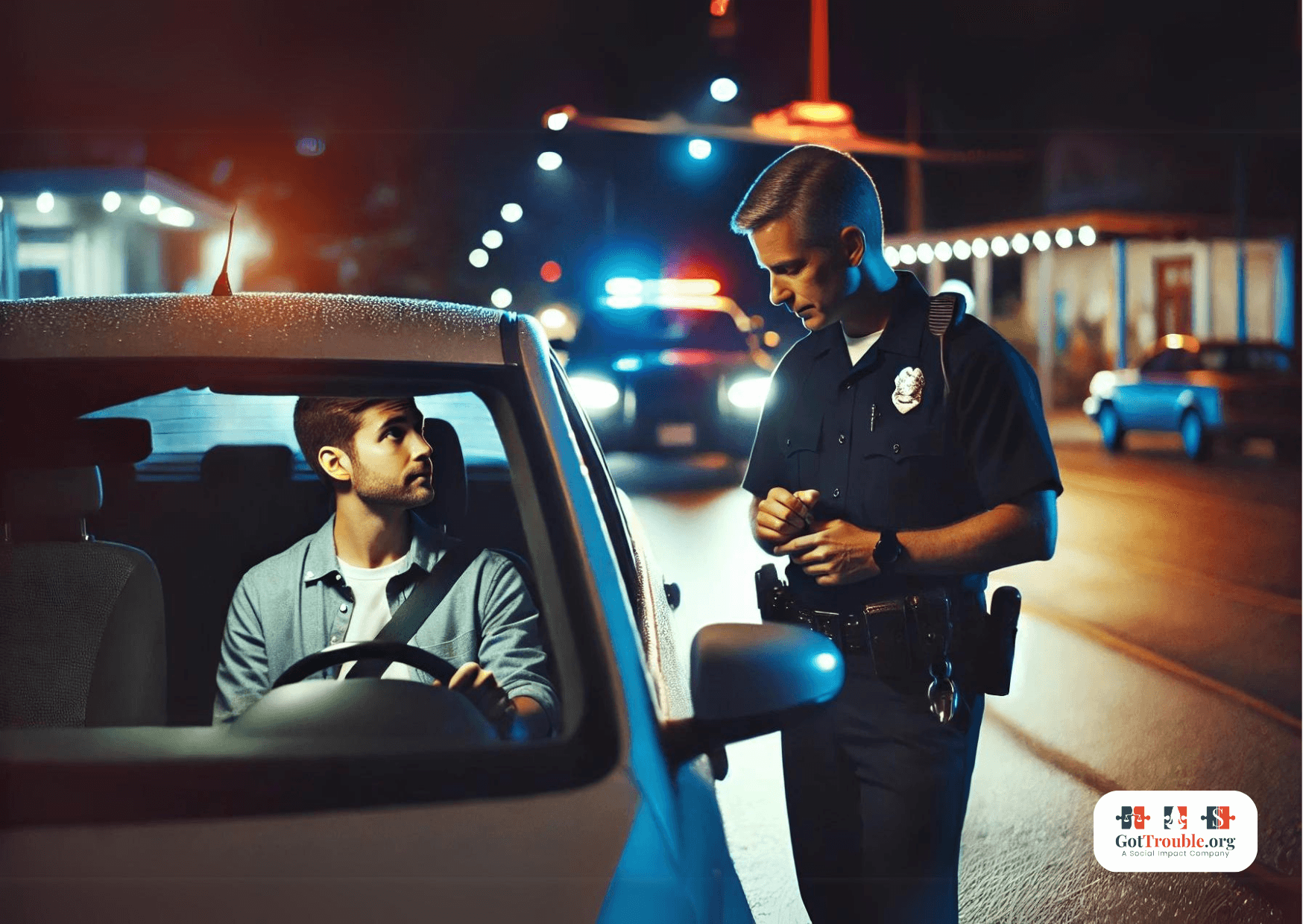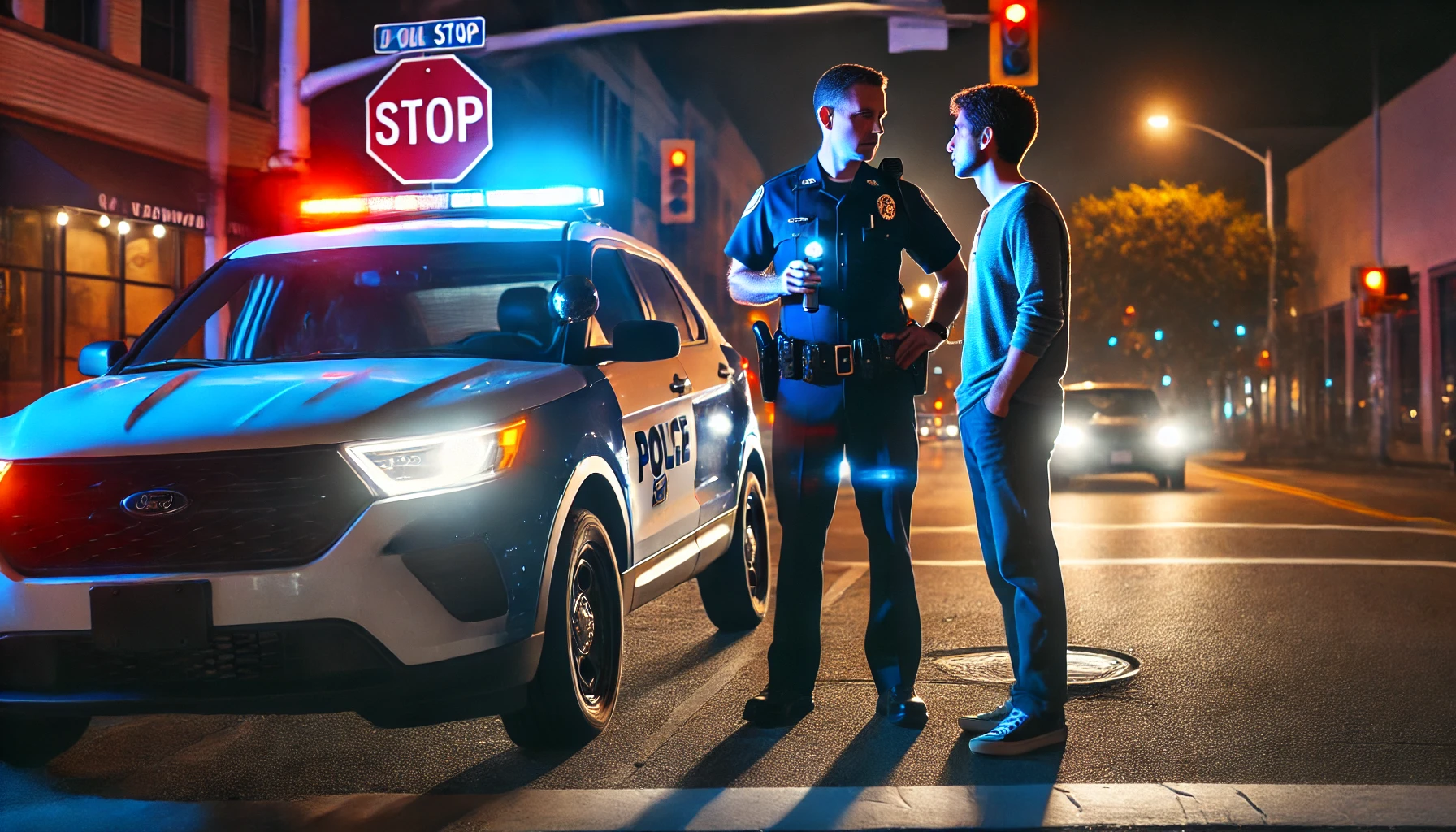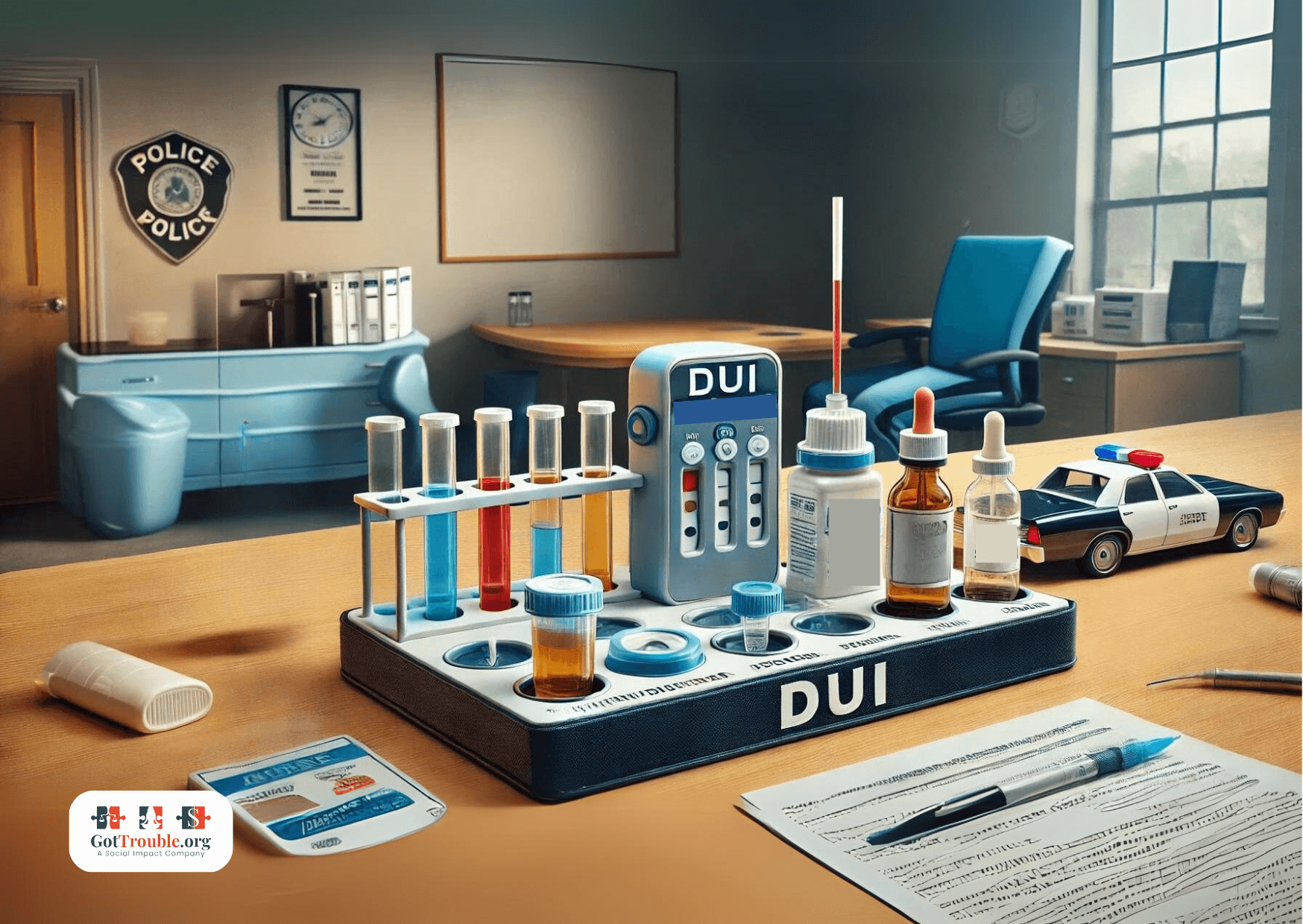Stopped, Detained, And Arrested for Drunk Driving
A driver is said to be under the influence if, at the time of driving, the driver was so impaired by alcohol or drugs that the driver could not operate a motor vehicle safely.
Range of DUI Charges and Penalties
Depending on the state, the charges and convictions for a drunk driving offense can range from a Misdemeanor First-Time DUI offense (the penalties are usually a combination of probation and 48 hours of community service, fines, DUI classes, and driving restrictions…) to a Felony DUI Manslaughter with Priors, (penalties can include serving substantial state prison time, restitution, thousands of dollars in fines and court costs and the permanent revocation of the offenders driving privileges).
Drunk Driving Investigations Driven by Three Major Factors:
- Results From Field Sobriety Tests
- Results From Chemical Tests
- Evidence of Dangerous and Erratic Driving
What This Drunk Driving Article Covers:
This article covers the investigative stages of a drunk driving traffic stop, detainment, and arrest. We will also discuss the factual and legal requirements the officer must follow at each stage of the process, including:
- The initial contact between the officer and the driver and the legal requirements for the officer to request the driver exit the vehicle and perform field sobriety tests.
- The types and accuracy level of field sobriety tests and how your defense lawyer can legally challenge them in court.
- The inherent and subjective weaknesses of field sobriety tests to accurately measure the level of driver impairment.
- The legal requirements needed to arrest the driver and request the driver submit to one of three chemical tests: blood, breath, or urine.
- Determining the accuracy of blood, breath, and urine tests and how your defense lawyer can challenge the accuracy of these tests.
How Do Police Gather Evidence in DUI Cases?
What Evidence Is Needed to Stop and Detain a Driver?
All drunk driving cases start with contact between a motor vehicle driver and a police officer. While the police have the right to approach and speak with anyone, they do not have the right to stop, detain, and investigate someone unless they have an articulable “reasonable suspicion” that a crime has been committed.
What Evidence Is Required for a Legal DUI Arrest?
To make a lawful arrest, the officer must conclude from the evidence that there is “probable cause” to believe the driver was impaired by alcohol or drugs and was unable to operate the vehicle safely.
Suppose the drunk driving defense attorney can prove the officer did not have an articulable “reasonable suspicion” to stop the vehicle or lacked the “probable cause” to make an arrest. In that case, the court may dismiss the case as a matter of law.
However, obtaining a dismissal based on these grounds rarely happens in drunk driving cases. This is because police have been well-trained in selectively documenting instances of reasonable suspicion and probable cause in their police reports.
For example, the officer can state in their police report that he observed the vehicle swerving between lanes of traffic. This single observation would be enough evidence to pull the driver over and further investigate the matter.
Can a Police Officer Stop and Detain You for Minor Violations?
Yes, most detentions begin with the officer pulling over a driver who has committed a minor vehicle code (infraction) or appears to be driving in an unsafe manner.
Legal Reasons for Stopping the Vehicle
The most common reason to stop and detain a driver is to observe poor driving, such as speeding, swerving between lanes, or running a stop sign or red light.
However, faulty equipment (headlight, taillight, muffler) or expired registration tags will also provide the necessary pretense to pull a driver over.
What Happens After the Driver is Pulled Over?
Police Officer Looks for Signs of Impairment
The police officer begins their investigation when approaching the car. As the driver rolls down the window, the officer will check among other things:
- If the driver smells of alcohol
- If the driver’s eyes are watery or bloodshot
- If the driver is having trouble retrieving their driver’s license
- If the driver’s speech is thick or slurred.
From the officer’s observation, if the officer does not have an articulable reasonable suspicion to believe the driver is under the influence of alcohol or drugs, technically, the police officer must allow the driver to drive off. However, this rarely happens.
Again, technically, the officer cannot order the driver out of the car to perform field sobriety tests unless they have probable cause to continue the investigation.

Police Officers Initial Face-to-Face Contact with Driver
Possible Signs of Impairment
Police officers who pull a driver over at night have been trained at the police academy to look for signs of driver impairment in a driver. It should be no surprise that officers are not trained to look for signs of sobriety in a driver’s appearance and demeanor and to mention those observations in their police reports.
Let’s take a closer look at what police officers consider evidence of drunk driving.
Smell of Alcohol
Other Possible Sources of Smell
The smell of alcohol might be in the car even if the driver was not drinking.
The smell of alcohol may be coming from the passenger and not the driver. Even if the driver was at a bar, it is not unusual to smell from stale cigarette smoke and alcohol, even if the driver had not consumed alcohol.
While these are all possibilities, the officer will be inclined to conclude the driver has likely consumed alcohol.
Drivers Bloodshot and Watery Eyes
Other Possible Causes
There may be several reasons the driver has watery eyes, none of which necessarily indicates a lack of sobriety.
The driver may be operating on very little sleep, may have worked all day at a computer terminal, may be suffering from a cold or allergies, or the redness could have been caused by cigarette smoke.
Remember that the officer has never seen the driver before and has nothing to compare his observations to.
Notwithstanding, the officer had observed the driver’s bloodshot and watery eyes, which he will likely consider a factor supporting the officer’s belief that the driver is impaired.
Driver Fumbling Through Their Wallet
People organize wallets in many ways. Some leave their registration in the glove compartment. Some keep their driver’s licenses with their credit cards, and some keep them all together, only separating the cash from the other items. And some people do not even use a wallet.
In fact, some people would have trouble finding their driver’s license if they were stone sober, in broad daylight, and it was chained to their waistbelt. The point here is that being pulled over by a police officer late at night makes most people nervous enough to appear disorientated when asked to retrieve their driver’s license.
Again, this is another factor that may support the officer’s suspicion that the driver is likely impaired. These factors alone may have nothing to do with the driver’s sobriety.
Drivers Slurred Speech
While an officer may associate slurred speech with driving under the influence, it may also be a side effect of certain medications or medical conditions.
Remember, the officer has never spoken to the driver before and, therefore, has no idea how the driver’s voice sounds under normal conditions.
The driver may have a deep voice and cannot articulate his words clearly. This is especially true if the driver is nervous and tired.
A Constellation of Factors Supporting Driver Impairment
The officer is said to rely on a constellation of factors that together can suggest the driver may be impaired.
While one of the above factors may not be enough for the officer to have a reasonable suspicion of impairment, a combination of factors would provide the officer with reasonable suspicion to continue the investigation by having the driver perform field sobriety tests.
Sobriety tests will determine whether the officer has sufficient probable cause to arrest the driver based on how well or poorly the driver performs on these tests.

Field Sobriety Tests (FST)
Field Sobriety Tests – Unpacking Their Role and Reliability
The investigation into a suspected DUI often begins with standardized field sobriety tests administered by a law enforcement officer.
These tests may include the horizontal gaze nystagmus test (discussed later in this article), which most police consider critical in establishing a driver’s physical and cognitive impairment.
While these tests are standardized, different police officers can interpret them differently, making it crucial for a DUI attorney to examine their administration of these tests closely.
Least Effective Way of Proving Impairment
Most drunk driving defense lawyers will argue that field sobriety tests are the least persuasive evidence of impaired driving because it is based on the subjective observations of the police officer.
The driver is usually first ordered out of their vehicle. While standing on the side of the road, an officer places the driver through a series of balance, coordination, and mental cognition field sobriety tests.
While each jurisdiction uses its own standard methods for field sobriety testing, some tests are used by practically all police agencies.
These usually include. the following:
Balance Tests
Let’s be honest here – not everyone is a ballet dancer or performed for Cirque du Soleil.
Standing on one foot, walking an imaginary line in the dark, and leaning backward while having your eyes closed are all balance and coordination tests. However, your defense lawyer will argue that none of these should be considered conclusive evidence establishing a driver’s level of sobriety.
For example, innocent factors affecting balance might have been caused by the physical location and conditions where the driver was tested.
These might include:
- Being tested for balance at the side of a busy highway with glaring headlights entering the driver’s field of vision while attempting to focus on the test.
- The testing area was poorly lit.
- The road’s surface was uneven or sloped.
- Weather conditions such as cold, windy, rainy, or snowing might have made such testing problematic.
- The person being tested naturally has an unsteady gait or balance problem from natural causes because of a foot or leg injury or merely because the driver was wearing stiff or slippery dress shoes.
The experienced defense lawyer can use all the above factors in court when cross-examining the officer at trial.
Coordination And Mental Tests
The following are common balance and coordination tests officers ask the driver to perform:
- Touching Fingertips: Asking the driver to touch one’s fingertips from their thumb to their pinky finger while counting the taps out loud forward and backward.
- Alternate Hand Clapping: What does this even mean? Say nothing of ever performing such a task.
- Finger-To-Nose Test: The investigating officer asks the driver to place their index finger and touch the tip of their nose while alternating their arms, with their eyes closed. If that isn’t enough, the officer asks the driver to count out loud backward, by twos, beginning with 100.
- One-Leg Stand Test: For the one-leg stand test, the officer instructs the driver to stand with one foot about six inches off the ground and count aloud by thousands, such as one-thousand-one, one thousand-two…while holding that position for thirty seconds. Should the subject use their arms to balance, hop, or let the raised foot touch the ground, the officer will note these deviations in their police report.
Lawyer Testimonial
Cross-examination of arresting officer:
Once at a DUI trial, during cross-examination of the arresting officer, I asked whether the officer could demonstrate a field sobriety test for the jury. He left the witness box and in front of the jury, the officer demonstrated the tests he asked my client to perform on the night he was arrested. I asked him how many times in his career had he demonstrated those types of field sobriety tests. He replied, probably over a hundred times.
I then asked the officer to recite the alphabet backwards starting from the letter “R” which he visibly had trouble doing. When I asked the officer why he was having trouble performing the test, he replied that he was never trained on that test at the police academy.
When I asked the officer whether he knew whether the defendant was ever trained on any of the field sobriety tests he asked my client to perform that night, the officer replied in the negative.
The jury returned a verdict of not guilty.
(California Trial Attorney H.D.)
Officer’s Subjective Observations
Interpreting these tests is highly subjective and many can be explained away depending on what happened when they were administered.
Not only do the location and conditions of the field sobriety test affect the outcome, but the officer might not be adequately explaining what is being asked of the subject.
Remember, the investigating officer has demonstrated these tests countless times and expects the subject to get them right the first time he is asked to perform them.
Finally, officers are trained to report on evidence that will support a conviction and to disregard reporting evidence that supports a driver’s acquittal.
The officer’s one-sided view more often than not predisposes them to conclude that the driver was too impaired to drive a vehicle safely.
What Is the Horizontal Gaze Nystagmus Test?
The driver is asked to follow the officer’s pen with the eyes without moving their head. The officer looks to see if the eye pupil “bounces” as it follows the pen. However, this can be an unreliable indicator of alcohol consumption. Antihistamines, certain eye conditions, or extreme lack of sleep can cause nystagmus.
The Officer’s Expert Conclusions
A One-Sided Interpretation
While the officer may conclude that some or all of the above observations were evidence of intoxication and impairment, an experienced trial defense attorney will be able to counter every one of these observations with objections and alternative reasons that have little or no bearing on whether the driver was impaired and could not drive safely.
No matter how strong the officer’s case on field sobriety tests may be, it will always be measured against the results of the chemical tests.
If the driver’s breath, blood, or urine test results are significantly over the legal limit, not even the best drunk driving lawyers can make the case go away.
Driver’s Dos and Don’ts During a DUI Investigation
Dos:
- Stay Calm and Composed: Nervousness can be mistaken for impairment, so try to stay as calm as possible when interacting with the officer.
- Know Your Rights: Be respectful but also be aware of your right to refuse specific tests, though doing so will have legal consequences.
Don’ts:
- Don’t Volunteer Extra Information: Only provide what is legally required; excessive talking will almost always be used against you.
- Don’t Perform Field Sobriety Tests If You’re Injured: You can politely decline field sobriety tests if you have a limiting physical condition, such as a bad back or knee injury, but know that this may result in immediate arrest depending on the circumstances. You should also be prepared to provide your defense lawyer with medical documentation of these injuries.

What Are the Different Types of DUI Chemical Tests?
Strongest Evidence to Prove Impairment
As of 2024, almost all states consider a blood alcohol concentration (BAC) that exceeds 0.08 as per se conclusive of drunk driving. Many states, such as Arizona, impose penalty enhancements for drivers with a BAC of .15 or higher.
Now, it’s time to examine the three types of chemical tests used to prove driving under the influence in criminal cases.
Blood Test – Directly Measures Blood Alcohol Concentration
Blood Is the Most Accurate Chemical Test
A DUI blood test is the most accurate because it analyzes the blood directly. However, depending on the facts, an experienced criminal defense attorney will attempt to use the blood test result as a time marker and claim that the driver’s blood-alcohol level reached its maximum level when the blood was drawn at the police station and not when the defendant was driving.
Usually, the delay can be as many as thirty to forty minutes or more after stopping the driver to the time the blood is drawn from the defendant.
The delay in time allows the expert toxicologist to suggest that the driver had a BAC of less than .08 at the time of driving. This is known as the rising blood alcohol defense.
Breath Test – Indirect Measure of BAC By Breath
Less Accurate Than Blood – Some Error Margin
Breath tests are commonly used to measure blood alcohol content (BAC) and are a staple of chemical testing procedures in DUI cases. It is considered less accurate than blood tests. This is because the Breathalyzer measures the driver’s blood content indirectly, through a person’s breath, and also because the Breathalyzer must be routinely and adequately calibrated to register accurate results.
In addition to these problems, the Breathalyzer is scientifically recognized as having an inherent margin of error of .01 percent. When these potential inefficiencies of the Breathalyzer are taken together, they allow defense counsel to challenge the accuracy of its results.
Urine Test – Indirect Measure of BAC By Urine
Least Accurate Chemical Test
- Urine tests are considered the least conclusive test for measuring the alcohol concentration in blood.
- An inconclusive result is neither positive nor negative and carries no convincing weight as evidence.
- An inconclusive result can be caused by a contaminated sample or an early-stage infection in the subject.
What Happens If You Refuse a Chemical Test After a DUI Arrest?
If a driver refuses to submit to a chemical test, there is no blood-alcohol result. While this may assist the accused, many states make refusing a chemical test a separate criminal offense.
Many states also suspend the driving privilege of someone who refuses to submit to a chemical test. Therefore, when confronted with an apparent refusal, an attorney might attempt to focus their fight on the allegation that the driver “knowingly refused” to take the test.
Did The Officer Give the Driver A Choice of Chemical Test?
- Did the officer allow a breath test if the driver feared their blood being drawn?
- Did the officer allow for a blood test if the driver could not complete a breath test due to a medical condition (asthma, lung ailments)?
- Did the officer adequately explain the consequences of refusing a test?
- Did the driver refuse, or did the officer lose patience with the driver and deprive him of his right to choose?
Under the legal pretense that driving is considered a privilege and not a right, most courts will suspend or revoke your driver’s license, impose substantial fines, or, under aggravating circumstances, even order jail time for the driver refusing to submit to a chemical test when suspected of a DUI.
The prosecutor need only prove that the driver was suspected of impaired driving and knowingly refused to submit to a test.
(Above Image) An oversized question mark illustrates how fears of being accused of drunk driving can turn into misconceptions regarding drunk driving investigations.
Misconceptions about DUI Investigations
Misconception #1: Field sobriety tests are foolproof indicators of intoxication.
Reality: Field sobriety tests are highly subjective and can be affected by factors like nervousness, medical conditions, or environmental conditions, making them unreliable as sole indicators of impairment.
Misconception #2: Refusing a chemical test will prevent DUI charges.
Reality: Refusing a chemical test can lead to immediate penalties like license suspension and may still result in DUI charges based on other evidence, such as field sobriety tests and officer observations.
Misconception #3: Breathalyzers provide accurate BAC readings.
Reality: Breathalyzers have a margin of error and can be influenced by factors like improper calibration, recent consumption of certain foods, or even medical conditions, leading to inaccurate readings.
Misconception #4: You must perform field sobriety tests if asked.
Reality: In most states, drivers can legally refuse field sobriety tests, though this may result in immediate arrest; however, refusal might not be used against them as strongly as failing the tests.
Misconception #5: All signs of impairment automatically mean DUI.
Reality: Signs like bloodshot eyes or slurred speech can be caused by non-alcoholic factors such as allergies, fatigue, or medical conditions and don’t always indicate alcohol or drug use.
Fears Related to Being Stopped For Drunk Driving
Fear #1: I worry that any traffic stop at night will lead to a DUI investigation.
Reality: While officers are more vigilant at night, a DUI investigation only begins if there is reasonable suspicion or observable signs of impairment, not automatically with every stop. Although, once stopped that will be looking for signs of impairment.
Fear #2: Failing a field sobriety test guarantees a DUI conviction.
Reality: Field sobriety test results can be challenged in court, and many other factors are considered in a DUI case, meaning a failed test doesn’t automatically result in conviction.
Fear #3: I’m concerned that refusing a chemical test will lead to severe penalties regardless of circumstances.
Reality: While refusal carries penalties, the consequences depend on state laws. In most states, a refusal in a drunk driving case can result in a favorable plea bargain. For most prosecutors, trying a case without scientific evidence of the defendant being “over the legal limit” that chemical tests provide can make securing a conviction more problematic and, for the defendant, increases the chances of obtaining a favorable plea bargain.
Fear #4: I was told that breathalyzers can detect alcohol even when not consumed.
Reality: Breathalyzers detect a person’s blood alcohol concentration, not just the presence of alcohol, and factors like mouthwash or certain foods might temporarily affect readings but are usually not mistaken for actual intoxication.
Fear #5: Is it true that the police can arrest you for DUI without having solid evidence?
Reality: It depends on what you mean by solid evidence. Police need reasonable suspicion to stop and probable cause to arrest. If these standards aren’t met, evidence can be challenged, and cases may be dismissed or charges reduced.
Prevention and Public Awareness
Statistic: According to Responsibility.org, research has shown that approximately 25% of individuals arrested and 30% convicted of DUI are repeat offenders (Warren Kigenyi and Coleman, 2014).
Key Takeaways
Essential Points to Remember
- Understand Your Rights and Responsibilities: Knowing your legal rights during a DUI stop can significantly impact the outcome. Stay informed about what you can and cannot do when interacting with law enforcement to protect yourself effectively. But again, be respectful when responding to the officer’s questions.
- Field Sobriety Tests Are Subjective: These tests aren’t foolproof and can be influenced by numerous factors unrelated to alcohol consumption. Recognizing their limitations and discussing any concerns with your lawyer is important.
- Chemical Test Results Can Be Challenged: Although chemical tests are considered strong evidence, inaccuracies and procedural errors occur. An experienced drunk driving defense attorney can scrutinize these results and potentially have them dismissed or questioned in court.
- Refusing Tests Has Consequences: In states like California, refusing to take chemical test can lead to immediate penalties, including license suspension and additional charges. Weigh the potential outcomes carefully before deciding.
- Legal Representation Is Crucial: Facing DUI charges without proper legal support can be overwhelming and detrimental. A knowledgeable DUI defense lawyer can navigate the complexities of the legal system, challenge evidence, and work toward the best possible outcome for your case.
- DUI Can Result in Both Criminal and Civil Consequences. Consider the following article: Serious Consequences For DUI Offenders That Cause Accidents.
Consult With a Criminal Defense Lawyer
If you’re facing a DUI charge, a free consultation with a qualified DUI attorney can be an invaluable first step. Given your case’s specific facts and circumstances, your attorney can provide insights into how chemical testing results might be challenged and the most effective defense strategies based on the facts of your case.












